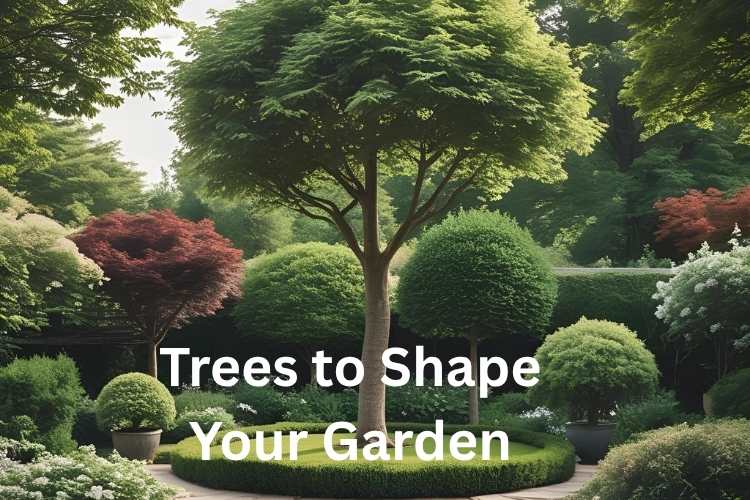Guide to Choosing the Best Garden Trees
15th Jun 2025
There is a space in everyone’s garden for a tree or two. Or even three. After all, garden trees play such an important part in our outdoor space. They bring character and structure to a garden and also great for the environment. Above all though they just look amazing and are so satisfying to plant and grow. Whether you want more privacy, provide a bit of shade, attract some wildlife, or just want to make your garden more beautiful, planting trees will do the job. In this article we’ll look at everything you need to know about garden trees, from choosing a tree to practical planting and care tips.
Assessing Your Garden
I did say that there is space in every garden for a tree. Of course, that is a bit of an exaggeration. If you’re gardening on a balcony or have a courtyard the size of a postage stamp, you’re probably not in the market for a garden tree. Bonsai may be more appropriate. But, the majority of gardens will have enough space even if you are simply planting trees on your patio. So, it’s fair to say that before choosing an ornamental tree spend a little bit of time thinking about your garden and the space you have, or don’t have, available.
Garden Size Considerations
If you have a small garden your space will benefit from compact or dwarf trees like Japanese maples or magnolias. Larger (read huge) gardens can accommodate expansive trees such as oaks, beeches, or large conifers.
Sunlight and Shade Levels
Identify sunny, partially shaded, or fully shaded areas in your garden and think about which type of garden tree will be most suitable for each part of the garden. Fruit trees typically require full sun, whereas others can tolerate some shade.
What’s Your Soil Like?
Most trees thrive in well-draining soil. Heavy clay or sandy limit your options though varieties like alder or willow may be OK.
Types of Garden Tree
There are basically four different types of trees you’ll be thinking about for your garden.
Small Garden Trees
Perfect for smaller spaces (obviously), small garden trees like crab apples, Japanese maples (Acer), and magnolias add colour and structure without taking over the full garden.
Fast-Growing Garden Trees
Ideal for quickly creating privacy or shade. Fast-growing trees like birch, poplar, and eucalyptus can make a massive difference to how your garden looks in just a few years. If you can buy mature trees, they will instantly transform your garden.
Evergreen Garden Trees
Evergreen trees such as laurels, pines, and cedars provide year-round greenery, acting as excellent privacy screens and windbreaks, particularly in winter months. Personally, I love evergreen trees and have a many different varieties in my garden. I just love the colour that is always there no matter the time of year.
Flowering Garden Trees
Flowering trees like cherry, crab apple, and magnolia just add a different dimension. They add plenty of colour and some, like a cherry blossom tree, are just downright spectacular.
Choosing the Right Garden Tree
This basically comes down to matching your personal preference to the size and conditions of your garden. Here’s a few things top think about:
Screening
If you’re looking for more privacy it goes without saying you should look for trees with dense foliage. Evergreens are your best friend here. Leyland cypress, laurels, and conifers are popular choices because they grow rapidly, have foliage year-round, and they will quickly block sightlines into your garden.
Decorative Features
So many ornamental trees can make a focal point in your garden. There are garden trees with unique features such as colourful blossoms, distinctive leaf shapes, or even attractive bark. Flowering cherries, Japanese maples, and fruit trees as they look stunning in season.
Low-Maintenance Trees
Let’s face it there aren’t many of us who relish the day-to-day chores in the garden. If this is you select hardy trees that don’t need much looking after. Robust varieties like hawthorn, silver birch, and mountain ash thrive with minimal care, pruning, and watering.
Wildlife
Most of us want to attract birds and pollinators to our garden. Choose species that offer food and habitat. Trees such as rowan, crab apple, and elder provide berries and blossoms that attract wildlife.
Seasonal Interest
Aim for year-round visual appeal by planting trees that provide interest across multiple seasons. Trees such as some cherries, magnolia, and Acer will provide colour and texture from spring blossoms through autumn leaf changes.
Size
Remember that small sapling in a pot will soon mature into something far bigger. Always think about how big the tree will be without pruning when it is mature. Make sure there is space in your garden for the tree to fully grow without taking natural resources and space from your other plants. maintain tree health and garden harmony.
Frequently Asked Questions
Planting Questions
When is the best time of year to plant garden trees?
Autumn and early spring are ideal, as the soil is warm and moist. This will help the tree’s roots quickly establish themselves.
How deep should I plant my garden tree?
Plant at the same depth the tree was growing in the pot, ensuring the root flare is just above soil level.
What spacing should I maintain between trees?
Spacing depends on the mature size of the tree. Generally, small trees require around 3-5 metres between each other, while larger trees need 7-10 metres. But all are different so make sure you know how big your tree will be when fully mature.
Should I stake a newly planted garden tree?
All young trees benefit from staking for stability. Especially if your garden is prone to winds. Use stakes driven securely into the ground, positioned away from roots, and secured with adjustable ties to allow for slight movement.
What should I do after planting my tree?
Mulching around the tree base helps retain moisture and suppress weeds. Protect young trees from pests and frost with tree guards or wraps if necessary.
Care and Maintenance
How often should I water newly planted trees?
You must regularly (at least once a week) water your tree during its first growing season. This should be adjusted according to weather conditions and soil moisture.
When and how should I fertilise garden trees?
Apply a balanced slow-release fertiliser in early spring or autumn. Don’t fertilise in late season as this can encourage vulnerable new growth.
How and when should I prune my garden trees?
Prune deciduous trees during winter when they are dormant. Prune flowering trees shortly after they bloom. Always remove dead or diseased branches as soon as you notice them.
How can I manage pests and diseases?
At some point you’re bound to come across pests like aphids and caterpillars or diseases like mildew, rust, and blight. Don’t be afraid to raid your local supermarket for sprays and organic solutions. Make sure you always have a good supply of these in your shed.
What routine care does garden trees need throughout the seasons?
Work into your schedule regular watering, annual mulching, seasonal pruning, and fertilise occasionally. Check regularly for signs of stress, pests, or diseases.
Garden Tree Ideas
There are so many ways in which an ornamental tree will improve your garden. Here’s a few ideas on how to add a tree or two to your garden:
Feature Tree
Usually called a specimen tree. A single tree such as a flowering cherry or magnolia can become a stunning centrepiece. Place it in the eye line to draw attention, surrounded by low-growing plants like hostas or colourful perennials. It’ll look amazing.
Avenue or Walkway Trees
If you have the space, you can create a pathway by lining it with trees that of the same variety or those which have seasonal changes. Ornamental pears, crab apples, or flowering cherries planted evenly along a walkway create a wonderful corridor. Personally, I have several small walkways flanked by low growing conifers.
Privacy Screens
If you require a natural screen, evergreen trees planted closely together, like Leyland cypress or western red cedar, provide a dense, attractive barrier.
Multi-Level Planting
Bring out the designer in yourself and combine trees of various heights, shapes, and foliage texture. Layering trees with shrubs and perennials will make a real difference to your garden display.
Container Planting
Many garden trees are ideal for container growing and will look fantastic in smaller spaces or on patios. Think about container-friendly trees such as dwarf olive, bay trees, or dwarf fruit trees for the patio. Containers offer flexibility in positioning and can be relocated to highlight different areas or to just follow the sun around.
You don’t have to overthink it but take some time in choosing the right trees for your garden and you’ll be rewarded with an amazing outdoor space in which you’ll spend many happy hours. Your trees will thrive, providing beauty, structure, and enjoyment for many years.
Don’t forget to check out our full range of garden trees and get them delivered direct to your door.


